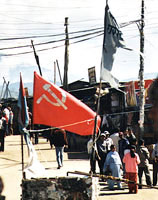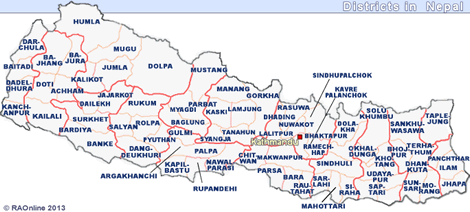|
Nepal's
war: Reports on the Conflict
|

|

 |
 |
|
Lamjung-Gorkha:
Clashes between army troops and Maoist rebels
|
|
November
24, 2002
|
|
The
Nepalese army is pursuing Maoists into higher mountain areas of Lamjung
following a second day of clashes in which dozens of Maoists are believed
killed. The army had been involved in fighting with the Maoists at Pulgiri-Ilampokhari
area (about 10 km southwest of Barpak (Gorkha) and 16 km east of Besisahar,
the district headquarters of Lamjung). |
Fighting
flared between a group of about 300 armed Maoists and army troops who had
moved to the area following intelligence reports of the Maoist movement
there. The army used armed helicopters to engage the Maoists, now believed
to be still holed up in the isolated jungle.
The
army has also claimed that they had discovered a Maoist training and hideout
center in the area. The Maoists are reported to have been gathering in
the area for a possible attack on Besisahar.
top
|
Ilam,
Sarlahi: Youths migrate to escape forced Maoist recruitment
|
|
November
23, 2002
|
|
Hundreds
of youths in Ilam and Surkhet districts have fled their homes after the
Maoist rebels started extortion and forced recruitment in their army. More
than 200 youths have fled their place in order to escape the forced recruitment,
local sources reported. |
The
Maoist rebels are insisting the youths working in their farmland to join
the rebellion. Many students have also fled their homes when the news of
forced recruitment spread like a wild fire around the area. A lot of youths
have taken refuge in the district headquarters to escape from forced recruitment
by the Maoists. Most of them want to migrate to India.
top
|
Jumla:
Headquarters under attack
|
|
November
15, 2002
|
|
Strong
Maoist rebel forces laid siege to Khalanga, the headquarters of Jumla district
(600 km west of Kathmandu) and launched a fierce attack. Following the
sudden attack, security forces exchanged heavy fires with the rebels. The
Maoists launched massive attack on Khalanga using long range weapons and
automatic weapons. |
Security
personnel from police, armed police and the army are deployed in the town.
The main target of the attack is said to have been the district police
office. The fighting is being described as some of the fiercest in recent
weeks and will almost certainly come as a setback to a peaceful resolution
of the six-year old Maoist insurgency. Details of the damage and casualties
are still unclear because the town of Khalanga is accessible only by air
or on foot. Sporadic encounters with the Maoists took place in the area
till late afternoon as army took positions in strategic areas around the
attacked site. It is confirmed that the Maoists had also attacked the Jumla
airport. Jumla is a popular tourist spot.
The
violence comes amid continuing efforts towards a negotiated settlement
to the conflict.
Jumla
to reconstruct
Maoist
rebels's attack devasted Jumla's district headquarters, Khalanga. An all-party
committee was formed now to initiate immediatelly reconstruction works
to the headquarters. The rebels had set fire to 18 government and public
buildings.
top
|
Dolakha:
Maoists targeted local bus
|
|
November
15, 2002
|
|
At
least two civilians lost their lives and several others sustained injuries,
when a passenger bus on its way to Kathmandu from Charikot, came under
a landmine planted by Maoist rebels near a bridge at Lankuri Danda. |
The
passengers injured by the landmine blast have been transported to to local
hospital in Dolakha, about 20 kilometres away from the site of the explosion.
Police personnel recovered a pressure-cooker buried under the road and
found a 500-metre long silk thread that extended towards the nearby hill
top. Vehicular movement along the Lamosanghu-Jiri Highway was rendered
ineffective for some time.
Maoist
top leader apologizes for death of civilians in ambush near Charikot
The
Maoist rebels have apologized to the general people for the death of two
passengers and the injury of 22 others when apassenger
bus was blown up in an ambush in Halhale of Dolakha district. Chairman
of the Nepal Communist Party NCP (Maoist) Puspa Kamal Dahal alias Prachanda
issued a statement extending his apology for the deaths and injuries and
said the party had not targeted any vehicles with the view to take the
lives of innocent citizens.
"We
were sad to learn that a passenger bus was blown up in an ambush in Dolakha
claiming the lives of two passengers and injuring 22 of them," Prachanda
has stated. Party-Chairman Prachanda has also suspected that anti-Maoists
could have carried out the act to defame his party. Prachanda has stated
that the party would look into the incident and bring out the facts before
the people if it is proved that the Maoists had laid the ambush. |
top
|
Maoist
rebellion's death toll: 'Over 7,000' deaths
|
|
November
01, 2002
|
|
More
than 7,000 people have been killed during six years of Maoist rebellion
in Nepal. According to official sources, more than 5,000 rebels lost their
lives in encounters. |
Since
the introduction of troops in the conflict a year ago the rebel's death
toll rised to 4050 dead fighters. About 1,200 soldiers and policemen, and
800 civilians make up the rest of the dead.
Experts
say it is almost impossible to verify casualty figures independently as
the rebels remove the bodies of their dead comrades from the battlefield.

|



